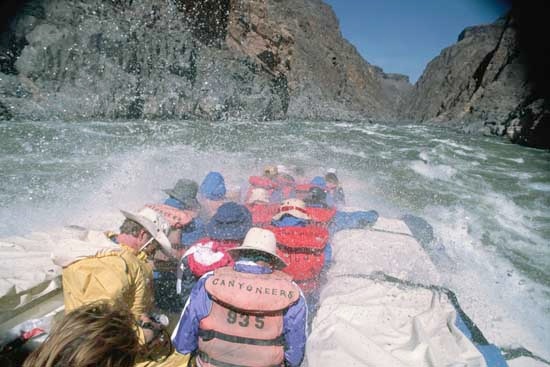wild-water racing
canoeing competition
also called white-water racing
competitive canoe or kayak racing down swift-flowing, turbulent streams called wild water (often “white water” in the United States). The sport developed from the riding of rapids in small boats and rafts (raft), a necessary skill for explorers, hunters, and fishermen. Later it became an increasingly popular form of recreation in parts of Europe and the United States.
International competition, which dates from 1950, has been dominated by Europeans. Contestants wear crash helmets and life jackets. They leave the starting point at intervals, and the person who covers a 2- to 5-mile (3- to 8-km) course in the least time is the winner. Although they compete in separate classes, the canoes and kayaks used are quite similar—decked over completely except for a hole for the rider, whose waist is wrapped with a plastic spray skirt to keep water out.
 In the United States the popularity of noncompetitive wild-water canoeing, kayaking, and rafting increased substantially during the last quarter of the 20th century, with millions of amateur adventurers testing their skills. The rapids and chutes of the Snake River in Idaho, the Cheat River in West Virginia, the Colorado River in Arizona, and the Nantahala River in North Carolina are particularly popular. The equipment and craft used in recreational wild-water pursuits are essentially the same as that used in competitions: durable covered canoes or kayaks with easy access and egress for the rider. Hundreds of commercial liveries serve wild-water enthusiasts on the more popular destinations, which are a significant boon to local economies.
In the United States the popularity of noncompetitive wild-water canoeing, kayaking, and rafting increased substantially during the last quarter of the 20th century, with millions of amateur adventurers testing their skills. The rapids and chutes of the Snake River in Idaho, the Cheat River in West Virginia, the Colorado River in Arizona, and the Nantahala River in North Carolina are particularly popular. The equipment and craft used in recreational wild-water pursuits are essentially the same as that used in competitions: durable covered canoes or kayaks with easy access and egress for the rider. Hundreds of commercial liveries serve wild-water enthusiasts on the more popular destinations, which are a significant boon to local economies.Worldwide, both competitive and recreational wild-water enthusiasts recognize and utilize a simple standard six-level designation for wild-water difficulty. The scale helps in planning routes and in avoiding dangerous sections of water:
● Class I—easy. The run contains only riffles and small waves through clear channels.
● Class II—novice. The run contains only moderate rapids and a few obstructions in a wide channel, with waves of less than 2 feet (0.6 metre).
● Class III—intermediate. The run contains numerous moderate obstructions that require maneuvering, with waves of up to 3 feet (1 metre). Scouting prior to making a run is advised.
● Class IV—advanced. The run includes long and violent rapids over rock drops and through turbulent passages that cannot be avoided, with waves of up to 5 feet (1.5 metres). Scouting prior to making a run is strongly advised.
● Class V—expert. The run consists of unbroken violent rapids through steep or congested sections that require a high level of physical exertion, with waves in excess of 5 feet (1.5 metres). Only highly accomplished experts should attempt this class, as the potential for injury or death is significant.
● Class VI—daredevil. The run consists of extremely dangerous waves and obstructions, which make the water virtually non-runnable. This class should be attempted by only highly trained teams after close inspection of the run; even then the risks of major injuries or death are substantial.
Additional Reading
Two good references are Jim Cassady and Dan Dunlap, World Whitewater: A Global Guide for River Runners (1999); and Paul Mason and Mark Scriver, Thrill of the Paddle: The Art of Whitewater Canoeing (1999).
- Harold Stephen Black
- Harold Ulrik Sverdrup
- Harold Varmus
- Harold Wagstaff
- Harold Washington
- Harold Wilson, Baron Wilson Of Rievaulx
- Harold W. Ross
- Haro, Luis Méndez de
- Haro Strait
- harp
- Harpagus
- Harpellales
- Harper
- Harper Brothers
- Harper, Frances E.W.
- Harper, Ida A. Husted
- Harper Lee
- Harper, Michael S.
- Harper, Robert Almer
- Harpers Ferry
- Harper's Magazine
- Harper, Stephen
- Harper, William Rainey
- Harpignies, Henri
- harpoon